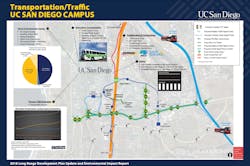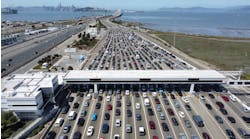By: Gabriel McFadden
Intelligent transportation systems (ITS) are defined as advanced and innovative ways to monitor or control the operations of traffic and various modes of transport.
ITS technology models are seen in apps that riders use to monitor train or bus schedules, so they know when to leave the house or office. ITS even helps people to track shipments of online purchases, down to specific locations and expected delivery dates. Perhaps the most compelling use of ITS technologies like GPS, is the assistance it provides to first responders in navigating real-time traffic, weather, or even hazardous material conditions, while en route to providing swift aid to the public.
Really, the examples and human benefits of ITS are many, and they enable transit and transportation users to make more informed, safer, more coordinated, and 'smarter' use of transport networks. While ITS initiatives are not a new thing, and various cities have been pursuing similar connected projects for years, one recent and admirable example of unique use of ITS technologies is taking place at the University of California San Diego (UC San Diego).
The university, in partnership with firm Linscott, Law & Greenspan, Engineers (LLG) as well as San Diego-based Cubic Transportation Systems, have embarked on transit and traffic management projects to ensure safety on campus and on the surrounding roads. The ultimate goal is transforming the city of San Diego into a connected ‘smart city’ with future-proof integrated transit systems that ensure community safety and efficient use of transportation resources.
An avant-garde approach to intelligent transport
UC San Diego figures prominently in the community of San Diego. As such, the school evaluates campus planning every 10-15 years, to consider population growth and the impact on the surrounding roadway systems. LLG helped develop this program as a way to improve traffic flow coming to and from the UC San Diego campus. It is somewhat unique for a university to be leading the efforts of intelligent transport for a major metropolitan area, but with a student population of more than 30,000—and one in every 17 jobs in the city of San Diego (62,516 jobs) linked to the university—the campus figures prominently into the surrounding community.
The UC San Diego project is currently near-deployment and has become one of the city’s most extensive ITS projects to date. It features adaptive traffic signal control technology at 26 intersections in support of UC San Diego’s Long Range Development Plan (LRDP). The breadth of the project becomes clearer when contrasted with other projects of this nature, which typically only provide signals at a small handful of intersections.
Other portions of the plan include Adaptive Traffic Signal Control (ATSC) on Regents Road and La Jolla Village Drive, corridors that connect the I-5 and I-805 freeways. The ultimate purpose and benefit of using adaptive and smart signals is cutting carbon emissions. This happens through improved traffic flows when the sensors, along with artificial intelligence technology, adjusts signals in real-time based on traffic volume, resulting in less time that cars spend idling at red lights.
Transit signal priority (TSP) will be used on Regents Road and La Jolla Village Drive corridors, including the I-5 and I-805 interchanges, to improve regional bus service and integrate existing buses with the future Mid-Coast trolley stations. TSP is currently employed in the SuperLoop system at 40 intersections in the University City community operated by the City, Caltrans, and UC San Diego.
Foot and bicycle traffic are also factoring into the plans with mobility and safety improvements, including high visibility crosswalks at locations that are heavily utilized by pedestrians or cyclists from outside UC San Diego campus communities. Additionally, there are new traffic signals at eastbound La Jolla Village Drive and Gilman Drive, and crosswalk relocation at La Jolla Village Drive and Torrey Pines Road.
Future impacts reach far beyond UC San Diego campus
Overall, the UC San Diego project is not just a step forward in traffic management and modernization for the university. It has taken on a broader importance as a massive leap forward thanks to cross-system collaboration and integration between the City of San Diego and its regional agencies like Caltrans, SANDAG, and MTS.
One major difference in the early success of the project and its continued development has been the community, which has been very receptive to the new, tech-based solutions. Often, people can be skeptical of technology, especially when it is new and unfamiliar to them. Perhaps because of the high traffic congestion in the surrounding community, and its desire to avoid roadway modifications like widening to alleviate the issue, the tech-based initiatives have caught greater support.
Ultimately, the UC San Diego project is a stepping stone to what will eventually transform San Diego into an intermodal smart city, becoming a model for other American cities to consider the possibilities of ITS. This means that in the future, San Diego could see any number of ITS technologies being used to create operational efficiencies on its roads and transit systems such as: applications to monitor automatic plate number recognition or speed cameras; automatic incident detection or stopped vehicle detection systems; more advanced applications that integrate live data and feedback from a number of other sources, such as parking guidance and information systems; weather information; and the like. Additionally, predictive techniques are being developed to allow advanced modeling and comparison with historical baseline data.
The project at UC San Diego is just one case study, but it effectively illustrates many of the broad possibilities for ITS technologies, and how much opportunity exists to improve, enhance, and innovate our transportation and transit systems to positively impact the quality of life in American cities and towns. For ITS initiatives to continue making improvements, the public and private sectors must work together to envision a future with sustainable and efficient solutions.
About The Author: McFadden is senior business development manager for Cubic Transportation Systems.




